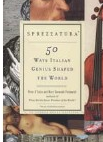“Bravo”, “ciao”, “arrivederci” you don’t have to be in Italy to understand what someone is saying to you. These are all words most of us not only understand but possibly even use in conversation. But how about vedemu ciu tardi (see you later) or bela tusa (pretty girl)? If you don’t understand, you’re not alone. In fact, most Italians would have no idea what these phrases mean since they are in Genovese, Piemontese and Milanese dialects.
A dialect, according to Webster’s, is a regional variety of a language distinguished by pronunciation, grammar, or vocabulary, esp. a variety of speech differing from the standard literary language or speech pattern of the culture in which it exists. Throughout the years, dozens of dialects have developed on the Italian peninsula because of the historical and political forces that contributed to the country’s long-term fragmentation. Today, you still hear dialects spoken throughout Italy especially in certain regions such as Sicily, Sardenia and in the Aosta Valley. Modern Italian, however, predominates throughout the country.
After the fall of the Roman Empire, fifteen centuries passed before Italy became politically unified. Latin was the lingua franca during the years of Roman occupation. Local forms of spoken Latin (also know as Vulgar Latin) arose and from this oral tradition were born the regional dialects of the Italian peninsula. Since what we know today as Italy was ruled for so long by various potentates and princes, no specific national language was established and local dialects flourished.
The dialects, like any language, were influenced by the historic and geographic characteristics of their particular regions. For instance, in Genovese the word for “umbrella” is “paraegua” which is similar to the French word “parapluie.” This is not surprising because Genova was indeed part of a kingdom that included parts of South-Eastern France.
 Today, dialects are no longer the preferred or most common means of communication in Italy. The modern Italian language has come to dominate and three notable events have contributed to this evolution. The first was the publication of Dante’s “Divine Comedy”. The second was the political unification of Italy. The third was the explosion of media in the latter half of the 20th Century.
Today, dialects are no longer the preferred or most common means of communication in Italy. The modern Italian language has come to dominate and three notable events have contributed to this evolution. The first was the publication of Dante’s “Divine Comedy”. The second was the political unification of Italy. The third was the explosion of media in the latter half of the 20th Century.
When Dante set out to write the “Divine Comedy,” he decided that he would use his native Florentine tongue as opposed to Latin, which was the language of the educated. Dante’s choice was revolutionary; he wanted his text to be accessible to a mass audience and he preferred the actual texture of Florentine to that of Latin. By and large, the language in his masterpiece is the blueprint of modern Italian.
The second important event in the development of the Italian language did not occur for several hundred years. This would confirm the belief that one cannot rush a good thing. For centuries, Italy was divided into several distinct states ruled by diverse political entities. In the 1800s, Italy underwent its political and geographic unification under the leadership of Giuseppe Garibaldi and Count Camillo Benso di Cavour; during this period, the notion of an Italian national identity took root and along with it, the desire to establish a single national language.
The third pivotal factor that lead to the capitulation of dialects in favor of the diffusion of a national language was the rapid advancement of various forms of media beginning in the 1950s with national television networks. This trend continues today with the spread of the internet and the publication of a large number of regional daily newspapers in Italian. The use of dialect has become relegated to the pre-baby-boom generations. Before the media explosion, Italians were being taught Italian at school, but they still heard, used and often spoke their local dialects at home. However, young Italians were increasingly exposed to only the Italian of the media and, as the older members of their families died, the younger generations had nobody with whom to speak their dialects.
Further, as the media diffused the use of “proper” Italian, speaking your local dialect became less socially acceptable, and young people shied away from speaking in a way that was considered less educated and less mainstream. This attitude is, however, slowly changing in some areas as young people begin to appreciate the cultural heritage and linguistic richness of their regional dialects.
Keep this in mind during your next visit to Italy when somebody in Naples might refer to you as guaglione, meaning young man, or scignu (sir) in Genova. You might not know how to answer, but you will be able to appreciate the fact that you have experienced a momentof authentic Italian culture.
–Paola Buckley
ITALY: Suggested Reading
“Sprezzatura: 50 Ways Italian Genius Shaped the World” by Peter d’Epiro and Mary Desmond Pinkowish
 The art of effortless mastery, or Sprezzatura, is a term used by authors Peter D’Epiro and Mary Desmond Pinkowish to describe some of the many ways Italians have contributed to modern society. Their book consists of 50 self-contained chapters, each filled with surprising information and anecdotes pertaining to different ways Italians have influenced western civilization. The first chapter explains the introduction of the Roman calendar. Subsequent chapters describe the creation of the earliest medical school, the birth of opera, and the development of a new era in childhood education. You will enjoy reading about notable Italians such as St. Thomas Aquinas, Leonardo da Vinci, Catherine de Medici, Roberto Rossellini, and Ferrari. The final chapter is dedicated to Italy’s well known fashion industry.
The art of effortless mastery, or Sprezzatura, is a term used by authors Peter D’Epiro and Mary Desmond Pinkowish to describe some of the many ways Italians have contributed to modern society. Their book consists of 50 self-contained chapters, each filled with surprising information and anecdotes pertaining to different ways Italians have influenced western civilization. The first chapter explains the introduction of the Roman calendar. Subsequent chapters describe the creation of the earliest medical school, the birth of opera, and the development of a new era in childhood education. You will enjoy reading about notable Italians such as St. Thomas Aquinas, Leonardo da Vinci, Catherine de Medici, Roberto Rossellini, and Ferrari. The final chapter is dedicated to Italy’s well known fashion industry.
Sprezzatura: 50 Ways Italian Genius Shaped the World is a wonderful insight into the Italian culture. It could be valuable reading for anyone moving to Italy or studying its history.
–Lorraine Gachelin

